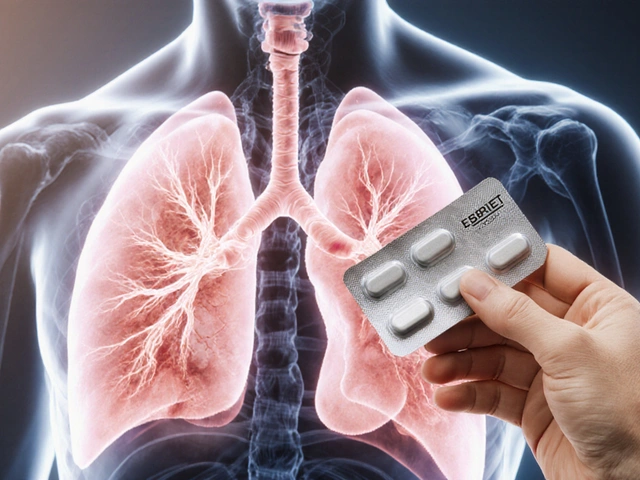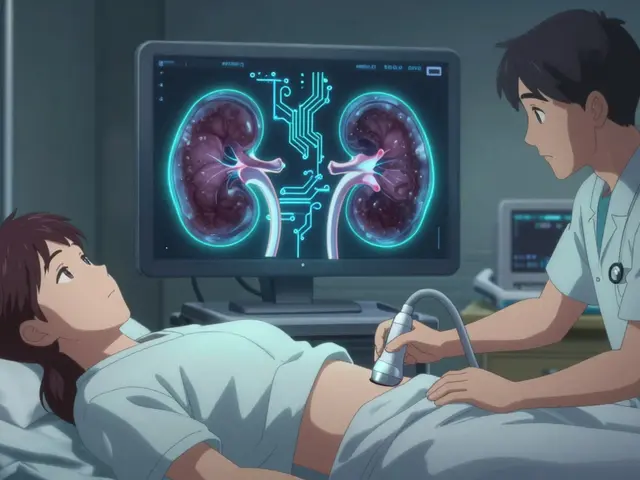
Health October 4, 2025
Genetics and Idiopathic Orthostatic Hypotension: What the Evidence Shows
Genetics of Idiopathic Orthostatic Hypotension: Gene Explorer
This tool helps you explore key genetic variants linked to idiopathic orthostatic hypotension (IOH). Each gene plays a role in regulating blood pressure when you stand up, and variations can disrupt this process.
Gene Overview
Select a gene from the dropdown above to see detailed information about its role in idiopathic orthostatic hypotension.
Key Genes in IOH Pathogenesis
SLC6A2
Encodes the norepinephrine transporter. Variants reduce transporter efficiency, leading to less norepinephrine available for vasoconstriction.
ADRA2A
Encodes the alpha-2A adrenergic receptor. Loss-of-function variants blunt the receptor’s ability to signal blood-vessel tightening.
NEUROD1
A transcription factor influencing autonomic neuron development. Rare missense mutations are found in families with clustering of orthostatic symptoms.
PHOX2B
Critical for autonomic nervous system maturation. Polyalanine expansions impair baroreflex sensitivity.
FLNA
Encodes filamin A. Truncating mutations are linked to vascular connective-tissue anomalies affecting venous return.
Important Note
These genetic variants do not act in isolation. Most patients carry a combination of risk alleles that together lower the threshold for an orthostatic blood-pressure fall.
When you or someone you know gets dizzy, light‑headed, or even faints after standing up, doctors often look for a simple cause-low blood volume, medication side‑effects, or heart problems. But what if none of those fit? That's where idiopathic orthostatic hypotension genetics enters the picture. This article breaks down how our DNA can tip the balance of blood pressure regulation when the cause isn’t obvious, and what that means for patients, families, and clinicians.
What Is Idiopathic Orthostatic Hypotension?
Idiopathic orthostatic hypotension is a form of a sustained drop in systolic blood pressure of at least 20mmHg (or diastolic drop of 10mmHg) within three minutes of standing, without an identifiable secondary cause. The term “idiopathic” signals that standard work‑ups-blood tests, cardiac echo, medication review-haven’t revealed a trigger. Patients typically report symptoms like blurred vision, weakness, or syncope, which can drastically reduce quality of life and limit everyday activities.
Why Genetics Matters in Blood‑Pressure Regulation
The body’s ability to keep blood flowing to the brain when you stand up hinges on a rapid cascade called the baroreflex a feedback loop that adjusts heart rate and vascular tone in response to changes in arterial pressure. Several genes encode proteins that fine‑tune this loop-adrenergic receptors, norepinephrine transporters, ion channels, and enzymes that synthesize catecholamines. When any of these genes carry a variant that blunts the signal, the baroreflex can’t compensate, leading to orthostatic drops even in the absence of disease.
Key Gene Variants Linked to Idiopathic Orthostatic Hypotension
Research over the past decade has spotlighted a handful of genetic players that show up more often in people with unexplained orthostatic hypotension. Below is a snapshot of the most reproducible findings:
- SLC6A2 the gene for the norepinephrine transporter, responsible for clearing norepinephrine from synaptic clefts. Certain single‑nucleotide polymorphisms (SNPs) reduce transporter efficiency, leaving less norepinephrine available for vasoconstriction.
- ADRA2A encodes the alpha‑2A adrenergic receptor, a key modulator of sympathetic outflow. Loss‑of‑function variants blunt the receptor’s ability to signal blood‑vessel tightening.
- NEUROD1 a transcription factor influencing the development of autonomic neurons. Rare missense mutations have been found in families with clustering of orthostatic symptoms.
- PHOX2B a gene critical for autonomic nervous system maturation; polyalanine expansions can impair baroreflex sensitivity.
- FLNA encodes filamin A, a cytoskeletal protein; truncating mutations are linked to vascular connective‑tissue anomalies that affect venous return.
These variants don’t act in isolation. Most patients carry a combination of risk alleles that together lower the threshold for an orthostatic blood‑pressure fall.
How Scientists Uncover Genetic Links
Modern genetics employs several strategies to pinpoint disease‑related genes. The most widely used in IOH research is the genome‑wide association study a method that scans thousands of SNPs across the genome in large cohorts to find statistical associations with a trait. For example, a 2022 GWAS of 4,800 European participants identified three loci near SLC6A2, ADRA2A, and a novel region on chromosome 12 that correlated with orthostatic blood‑pressure change.
When a GWAS flags a region, researchers dive deeper with whole‑exome sequencing sequencing that captures all protein‑coding regions of the genome to uncover rare, high‑impact mutations. Families with multiple affected members are especially informative; segregation analysis can confirm that a variant co‑inherits with the disease.
Epigenetic profiling-looking at DNA methylation patterns and histone modifications-has also entered the scene. Some IOH patients show altered methylation of the ADRA2A promoter, suggesting that gene expression, not just gene sequence, can modulate the baroreflex.

Genetic Testing Options for Patients
When a clinician suspects a hereditary component, several testing pathways exist. The table below outlines the main approaches, their strengths, and typical use cases.
| Method | Scope | Turn‑around Time | Cost (UK) | Best For |
|---|---|---|---|---|
| Targeted Gene Panel | 5‑10 known IOH‑related genes (e.g., SLC6A2, ADRA2A) | 2‑3 weeks | £300‑£500 | Patients with a clear family history or early‑onset symptoms |
| Whole‑Exome Sequencing (WES) | All coding regions (~20,000 genes) | 4‑6 weeks | £800‑£1,200 | When panel results are negative but suspicion remains high |
| Genome‑Wide Association Study (research‑only) | Millions of SNPs across the genome | 6‑12 months (research timelines) | Varies; typically covered by research grants | Contributing to population‑level knowledge; not for direct clinical diagnosis |
Most UK clinics start with a targeted panel because it balances cost, speed, and relevance. If the panel comes back empty and the clinical picture strongly suggests a genetic basis, patients may be referred for WES through a specialised genetics service.
Clinical Implications of a Positive Genetic Finding
Discovering a pathogenic variant does more than satisfy curiosity; it reshapes management in several ways:
- Tailored pharmacotherapy. Patients with SLC6A2 loss‑of‑function may respond better to drugs that boost norepinephrine release (e.g., midodrine) because their transporter can’t recycle the neurotransmitter efficiently.
- Avoidance of aggravating meds. Knowing an individual carries an ADRA2A variant can prompt clinicians to steer clear of drugs that blunt adrenergic signaling, such as certain antidepressants.
- Family screening. First‑degree relatives can be offered predictive testing. Early identification enables lifestyle modifications-gradual position changes, compression stockings-before syncope occurs.
- Enrollment in research trials. Many ongoing studies on autonomic disorders require genetic confirmation for eligibility, opening doors to experimental therapies.
Genetic counseling is a must. Counselors explain inheritance patterns-most identified variants follow an autosomal‑dominant trait with reduced penetrance, meaning not everyone with the mutation will develop symptoms.
Future Directions: From Polygenic Scores to Gene Editing
While single gene defects are exciting, the reality is that IOH is often polygenic. Scientists are already building polygenic risk scores aggregated metrics that weigh the contribution of many SNPs to estimate an individual’s genetic susceptibility. Early models suggest that a high polygenic score can predict a 2‑3‑fold increased risk of orthostatic hypotension in otherwise healthy adults.
On the therapeutic frontier, CRISPR‑based gene editing shows promise for correcting loss‑of‑function variants in cell models. Although human trials are years away, the concept hints at a future where a single‑shot fix could restore normal baroreflex responsiveness.
Another emerging area is the gut‑brain axis. Metagenomic studies reveal that microbiome composition can influence autonomic tone, and some genetic variants affect gut motility. Integrating microbiome profiling with genetics could usher in truly precision‑based treatment plans.
Key Takeaways
- Idiopathic orthostatic hypotension often hides a genetic underpinning that interferes with baroreflex signaling.
- Variants in SLC6A2, ADRA2A, NEUROD1, PHOX2B, and FLNA are the most consistently implicated.
- Genome‑wide association studies and whole‑exome sequencing are the primary tools for discovery and diagnosis.
- Targeted gene panels are the first‑line clinical test; positive results guide medication choices, family screening, and trial eligibility.
- Research is moving toward polygenic risk scores and gene‑editing strategies, promising more personalized care in the next decade.
Frequently Asked Questions
Can genetics explain why I only feel dizzy after standing, but not after sitting?
Yes. Genes that control norepinephrine reuptake or adrenergic receptor sensitivity can blunt the rapid rise in vascular tone needed when you stand. This leads to a pressure drop that isn’t seen when you’re seated because the baroreflex isn’t as heavily challenged.
Should I ask my doctor for a genetic test if my family members also faint?
If multiple relatives have unexplained orthostatic symptoms, a targeted gene panel is a reasonable first step. Discuss the test’s scope, cost, and the need for genetic counseling before proceeding.
Do lifestyle changes help even if I have a genetic variant?
Absolutely. Staying hydrated, using compression stockings, and rising slowly can reduce the frequency of drops. Genetics sets the risk level, but environmental factors still play a big role.
Is there any cure for genetic idiopathic orthostatic hypotension?
No definitive cure exists yet. Treatment focuses on symptom management-medications like midodrine or fludrocortisone, plus non‑pharmacologic measures. Ongoing research into gene‑editing may change that in the future.
How reliable are polygenic risk scores for predicting orthostatic hypotension?
Current scores explain only a fraction of the overall risk (roughly 10‑15%). They are useful as a research tool and may complement other clinical factors, but they shouldn’t replace proper diagnostic work‑up.
Write a comment
Items marked with * are required.






19 Comments
Tara Timlin October 4, 2025 AT 15:56
Great overview! The way you broke down each gene and its functional impact really helps clinicians connect the dots between genotype and the baroreflex failure you see in orthostatic hypotension. I especially liked the table summarizing testing options – it’s the kind of practical guide you don’t often get in a review article. If you’re looking for more resources, the recent ESC guidelines on autonomic disorders have a nice chapter on genetic work‑ups, and they suggest starting with a targeted panel before moving to whole‑exome sequencing. Also, patients with an SLC6A2 variant often respond well to norepinephrine reuptake inhibitors, so that could be a therapeutic angle worth exploring in future studies. Keep up the solid work!
Jean-Sébastien Dufresne October 7, 2025 AT 09:16
Wow!!! This article really hits the nail on the head!!! 😃👍 The genetics side is finally getting the attention it deserves – no more blaming everything on “old age”!!!
Patrick Nguyen October 10, 2025 AT 02:36
Clear and concise explanation of the genetic mechanisms involved. The focus on SLC6A2 and ADRA2A is spot on given their central role in norepinephrine handling.
Patrick Bread October 12, 2025 AT 19:56
Interesting take, but let’s be real – we’ve been talking about adrenergic receptors for years. The real challenge is translating these findings into bedside decisions, not just cataloguing SNPs.
Anyway, nice job on the summary.
Fiona Doherty October 15, 2025 AT 13:16
Honestly, this reads like a textbook. Where’s the patient perspective? People get dizzy every day, not just in a lab setting.
Neil Greer October 18, 2025 AT 06:36
Totally get where you’re coming from, but adding a short case vignette could bridge the gap between genetics and everyday symptoms. Even a quick “John, 42, gets light‑headed after standing” would help.
Fionnuala O'Connor October 20, 2025 AT 23:56
Thanks for the thorough breakdown; the emphasis on family screening is especially valuable.
Christopher MORRISSEY October 23, 2025 AT 17:16
Reading through this piece, I’m reminded of just how intricate the autonomic network truly is, and how a single nucleotide change can cascade into a cascade of physiological failures that manifest as that unsettling light‑headedness when we rise. The norepinephrine transporter, encoded by SLC6A2, has long been a cornerstone of sympathetic regulation, and the article correctly points out that loss‑of‑function variants diminish neurotransmitter reuptake, effectively throttling the vasoconstrictive response. Equally compelling is the role of ADRA2A; its alpha‑2A receptors serve as a brake on sympathetic outflow, and any attenuation here can blunt the reflexive increase in vascular tone. The discussion on NEUROD1 brings a developmental perspective, highlighting that not only the immediate signaling machinery but also the formation of autonomic neurons can set the stage for future dysautonomia. PHOX2B’s involvement in baroreflex maturation is another reminder that congenital factors can linger into adulthood, subtly compromising homeostasis. The inclusion of FLNA ties structural integrity of the vasculature into the picture, underscoring that genetics is not just about enzymes and receptors, but also about the scaffolding that supports blood flow. I appreciate the clear distinction the authors make between single‑gene effects and polygenic risk, as this mirrors what we see in large‑scale GWAS where multiple modest‑effect alleles combine to elevate susceptibility. The table summarizing testing modalities is practical; clinicians can quickly decide whether a targeted panel or whole‑exome sequencing is appropriate based on the clinical context. Moreover, the section on therapeutic implications-tailoring midodrine dosing for SLC6A2 carriers or avoiding certain antidepressants for ADRA2A variants-brings genetics out of the bench and into bedside care. Finally, the forward‑looking glimpse at polygenic scores and CRISPR‑based gene editing paints an optimistic picture of where the field may head, though we must temper expectations with the current technical and ethical hurdles. Overall, this article weaves together molecular detail, clinical relevance, and future prospects in a manner that is both accessible and scientifically rigorous.
Adam O'Rourke October 26, 2025 AT 09:36
Oh great, another “future of gene editing” hype piece. 😒 Sure, CRISPR is cool, but we’re still a decade away from fixing orthostatic hypotension in patients.
Mary-Pat Quilty October 29, 2025 AT 02:56
The philosophical underpinnings of attributing dizziness to our very DNA are fascinating – it makes one ponder how much of our daily experience is pre‑written in the double helix.
Patrick McGonigle October 31, 2025 AT 20:16
Indeed, while genetics provides a valuable lens, we must also regard environmental modifiers such as hydration status and medication load when assessing patients.
Keisha Moss Buynitzky November 3, 2025 AT 13:36
I appreciate the compassionate tone throughout the article; it acknowledges the patient’s lived experience while offering scientific insight.
Shivam yadav November 6, 2025 AT 06:56
From an Indian perspective, we often encounter familial cases of unexplained dizziness, so a targeted panel could be very useful in our clinics.
pallabi banerjee November 9, 2025 AT 00:16
It’s important to remember that access to genetic testing varies widely, and community outreach can help bridge that gap.
Alex EL Shaar November 11, 2025 AT 17:36
Honestly, the author’s enthusiasm feels forced. The data on FLNA is overblown – the connection to orthostatic hypotension is speculative at best. A more critical appraisal would have been welcome.
Anna Frerker November 14, 2025 AT 10:56
Typical lazy critique – you’re just cherry‑picking flaws without offering constructive alternatives.
Julius Smith November 17, 2025 AT 04:16
Nice article.
Brittaney Phelps November 19, 2025 AT 21:36
Glad you liked it! If you want to dive deeper, the recent Autonomic Neuroscience reviews are a goldmine.
Kim Nguyệt Lệ November 22, 2025 AT 14:56
This piece provides a solid foundation for understanding the genetic contributions to idiopathic orthostatic hypotension.